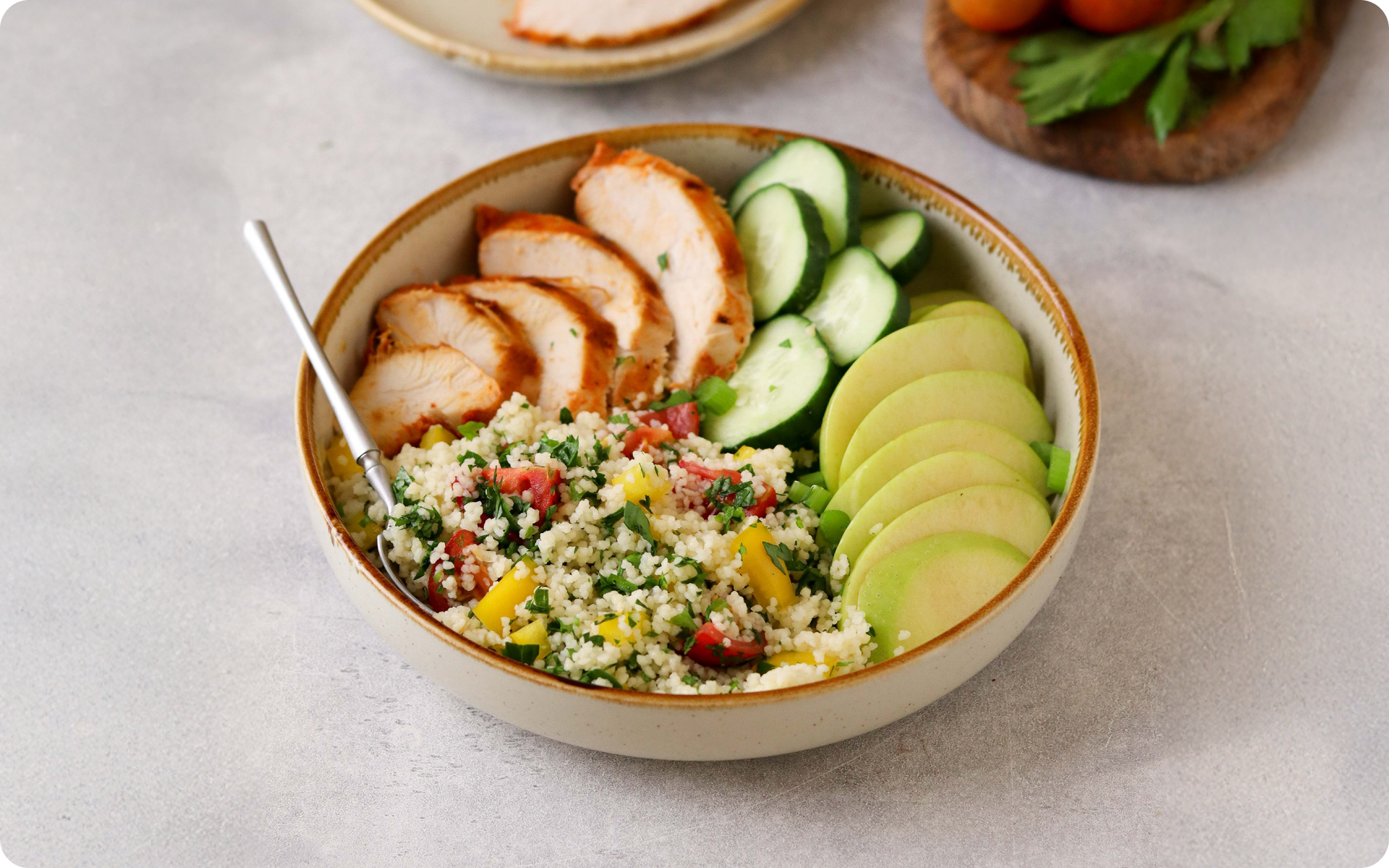Food cravings are more common than many of us like to admit. Cravings are tough to ignore and present as a yearning for a particular food. Cravings for chocolate and salty or sugary foods are among the most common.
Cravings are sometimes a sign that something is out of balance. Maybe you’re not getting enough nutrients, or you’re emotionally stressed (11). The urge to eat a particular food is twice as common in women than in men. Understanding the food cravings chart can help you better deal with those pesky food cravings.
What Are Food Cravings?
Food cravings are intense urges to eat a specific type of food. They can be powerful and overwhelming and cause an individual to feel as if they have no control over their cravings. Food cravings often involve foods high in sugar, fat, or salt.
These cravings can strike at any time, but are most commonly experienced during the late afternoon and evening. They can also occur as a response to emotions, such as stress, boredom, or sadness.
Our Motivation vs Discipline article explains how being motivated and disciplined may help you combat food cravings.
BetterMe is your fast-track ticket to a long-lasting weight loss! Tailor your fitness journey and maximize your results with just a couple of swipes!
The Food Cravings Meaning Chart
Sometimes cravings mean you aren’t eating enough overall. Sometimes they’re due to the menstrual cycle or pregnancy. Other times they don’t mean anything at all. Occasionally, they could be your body’s way of telling you your diet is lacking in a specific nutrient. A ‘food cravings and what they might mean’ chart shows the types of food you crave, what nutrients you could be deficient in. and types of food that are rich in those nutrients.
But in case you’ve never come across such a thing, you may be wondering how to handle food cravings. First, you should assess whether or not you’re eating enough or if your diet has become too restrictive or extreme. If you’re pregnant, your cravings are most likely due to the pregnancy and there’s nothing to be concerned about unless they’re for non-food items. In such a case, you should talk to your OB-GYN. Otherwise, you can look through weird food cravings and what they mean then identify the food you crave. Sometimes, though, all you really need to do is eat the food you’re craving and move on.
This food cravings deficiency chart looks at what certain cravings are sometimes said to mean and potential healthy eating alternatives to cravings for certain types of food. They are not definite or proven associations, so you should take them all with a grain of salt.
| Craving | What it might mean | What to eat instead |
|---|---|---|
| Chocolate | Magnesium deficiency | Green leafy vegetables, seeds, raw nuts, beans, fruits |
| Fatty or oily foods | Calcium deficiency | Spinach, kale, okra, broccoli, oranges, almonds, milk, sesame seeds |
| Bread | Nitrogen deficiency | Oatmeal, leafy green vegetables, nuts, legumes such as beans, peas, lentils, |
| Soda and other carbonated drinks | Calcium deficiency | Mustard greens, broccoli, kale, sesame seeds, legumes, cheese |
| Salty snacks | Chloride deficiency | Sea salt, celery, tomatoes, olives |
| Stress hormones fluctuations | Leafy green vegetables, B vitamins, vitamin C | |
| Coffee | Sodium chloride (salt) deficiency | Sea salt, regular table salt, kombucha, apple cider vinegar, seaweed |
| Sulfur deficiency | Garlic, kale, asparagus, onion, cranberries, cabbage, broccoli | |
| Phosphorus deficiency | Beans, lentils, pinto beans, pumpkin seeds, quinoa, nuts | |
| Iron deficiency | Spinach, legumes, meats, dried fruit, seaweed, cherries, plums, figs | |
| Sugary sweets | Low blood sugar (hypoglycemia) | *Check blood sugar if diabetic |
| Sulfur deficiency | Asparagus, garlic, kale, onion, cranberries, carob powder | |
| Tryptophan deficiency | Sweet potato, raisins, oatmeal, spinach, pumpkin seeds, sunflower seeds | |
| Chromium deficiency | Cinnamon, grapes, tomato, onion, apples, lettuce, sweet potato | |
| Phosphorus deficiency | Pinto beans, lentils, brazil nuts, pumpkin seeds, whole grains | |
| Cheese | Essential fatty acids deficiency | Flax oil, Omega 3s (EPA and DHA), walnuts, chia seeds |
| Calcium deficiency | Legumes, broccoli, kale, mustard greens, spinach | |
| Alcohol | Protein deficiency | Beans, lentils, peas, soybeans, leafy greens, nuts, seeds, eggs, fish, poultry, beef |
| Calcium deficiency | Legumes, mustard greens, kale, turnip greens, tahini, sesame seeds | |
| Potassium deficiency | Seaweed, tomato, citrus fruits, pineapple, banana, black olives, bitter leafy greens | |
| Glutamine deficiency | Bone broth, beets, parsley, cabbage, spinach, vegetable juice, beans | |
| Chewing on ice | Iron deficiency | *Talk to your healthcare provider |
| Pasta or baked foods | Chromium deficiency | Cinnamon, grapes, tomato, onion, apples, lettuce, sweet potato |
| Snacks (junk foods) | Unbalanced diet | Plenty of water, fruits, vegetables, protein, complex carbs, healthy fats |
Cravings are sometimes an indicator that your body is deprived of an essential nutrient. However, nutritional deficiency is not the only reason for food cravings.
If you’ve ruled out other triggers of cravings such as dietary restriction, stress, pregnancy, fatigue, or lack of sleep, you may have a nutritional deficiency.
For example, if you’re constantly yearning for chocolate, this may indicate that your body isn’t getting enough magnesium. A natural response would be to get a chocolate bar, but you should substitute it with foods such as leafy green vegetables, nuts, or fruits. Or, when you are craving soda or salty chips, you can opt for a healthier alternative by taking a quick look at a junk food cravings chart.
However, we sometimes experience cravings for emotional reasons, because we haven’t had something in a long time, or for no reason at all. It’s okay to simply eat the food you’re craving and move on.
Find out how to correctly identify the important nutrients you need for weight loss in our Counting Macros for Weight Loss article.
Factors That Cause Food Cravings
Several factors can cause food cravings. Understanding the causes of cravings is the starting point for managing them. When left unmanaged, uncontrolled food cravings can contribute to weight gain (3). These factors can be grouped into physical and mental (psychological causes) causes.
Physical Causes
Physical factors that cause cravings include:
Pregnancy. Food cravings are quite common during pregnancy. The hormonal changes during pregnancy may influence taste and smell receptors and cause intensified food cravings (8). They are generally nothing to worry about, and it’s fine to eat the food you’re craving as long as it’s safe in pregnancy. However, if you’re craving non-food items such as dirt or ice, you should talk to your doctor.
Lack of good quality sleep. Sleep is essential for the human body, just like diet and physical activity. During sleep, your body and brain rest so that you feel re-energized in the morning. Poor or inadequate sleep can cause imbalances in hormones that regulate hunger and satiety hormones, which can cause an increase in appetite and intensifying food cravings (5).
Dehydration. Thirst can easily be confused for hunger. Poor hydration may make you mistake thirst for hunger and intensify food cravings. Research has shown that drinking water before a meal may reduce energy intake (9).
Gut microbiota. Recent research has suggested a link between eating behaviors and gut flora. The presence of some types of bacteria may influence the type and frequency of cravings you experience (6).
Physical inactivity. An increase in your level of physical activity, be it taking a walk or going for a jog in the park, may help reduce cravings. At the same time, moving less than you normally do may cause you to experience more food cravings (3).
Eating ultra-processed foods: Research has suggested that processed foods rich in added fats and sugars may be associated with addiction-like symptoms. These may cause an increase in cravings for such foods (12).
Ghrelin and leptin dysregulation. Ghrelin, often called the hunger hormone, increases energy intake, stimulates appetite, and promotes fat storage. Leptin sends signals to the brain that the body has stored enough fat, thereby inhibiting hunger. An imbalance in these hormones, for example due to stress, may result in cravings and increased hunger pangs (10).
A nutrient-deficient diet. Nutrients such as fiber and protein help you stay full for longer. A diet that is deficient in these nutrients may make you feel hungry and cause increased cravings, even when you’ve eaten enough calories (1).
Missing crucial nutrients such as sodium chloride or magnesium is said to sometimes cause cravings for salty foods and chocolate. Looking through a food cravings chart for nutrient deficiency may help you identify where your cravings stem.
Premenstrual syndrome. Cravings are incredibly common in women just before their periods begin. Changes in the hormones progesterone and estrogen that occur during your period may cause cravings, particularly for carbohydrate-rich foods (8).
Low blood sugar levels. Low blood sugar is a major culprit behind food cravings. When you eat carbohydrates, your blood sugar levels increase, and the body releases insulin to let it into your cells where it can be used for energy. Low blood sugar occurs when there isn’t enough glucose circulating in the bloodstream. This typically happens during long periods of starvation or skipping meals. For people with certain medical conditions, blood sugar can become dangerously low.
When your blood glucose is low, the body may respond by causing you to crave foods that will raise your sugar levels. If you’re prone to hypoglycemia or have diabetes and you experience cravings for sugary foods or other symptoms, you should check your blood sugar immediately and treat it if necessary(4).
Read more: 3 Healthy Curry Recipes To Turn To When You Need Comfort Food
Psychological Causes
Food cravings can also have a mental aspect behind them. The mental (psychological) factors that cause food cravings include:
Stress. Cortisol is the body’s primary stress hormone. Stress can cause an increase in the level of cortisol. Stress, particularly chronic stress, disrupts homeostasis, and influences food choices, appetite, and eating habits.
Chronic stress sometimes increases wanting and appetite for calorie-dense and high-fat foods. High cortisol levels have been linked to hunger and cravings (10). Stress also results in a phenomenon called stress eating that generally causes an increase in energy intake.
Mood fluctuations. Certain mood states can cause cravings for specific types of foods. In particular, negative moods can trigger cravings for comfort foods (2).
Personality. Certain personality types have been linked to addictive-like behaviors. Research has suggested that individuals who are more impulsive or score higher on addictive personality scales may be more likely to experience food cravings (12).
Eating context. You’ve definitely heard the phrase ‘it’s all in your head’. As it turns out, the brain associates eating certain types of foods to a specific context. For example, popcorn and watching a movie. So the next time you’re watching a movie, you may crave popcorn.
If you’ve mustered up the courage to crush your weight loss goal, let Betterme take the sting out of this demanding process. Our app will help you restructure your habits, remold your life and crank up your fitness results!
Food Cravings and Emotions
There is a strong connection between food cravings and emotions. You may find that eating a certain type of food when you feel sad makes you feel better. As both nutrient deficiency and emotions may cause cravings for specific foods, you may confuse the two. In fact, it would be easier to think that a nutrient deficiency causes your cravings as this can be easier to manage.
Emotional eating involves eating particular foods that bring you comfort when you feel sad or upset. You may feel guilty after eating in such a manner, which can cause a cycle of overeating and issues such as weight gain and obesity. Although emotional eating affects both men and women, it is thought to be more common among women.
Food is sometimes used as a way to fill a void that results from negative emotions. Food may also offer comfort when an individual has retreated from social functions. Stress causes an increase in the level of cortisol which causes food cravings.
You need food to function properly, but it’s important to differentiate emotional hunger cues from actual hunger cues. There are several signs that differentiate emotional hunger from physical hunger, as shown below.
| Emotional hunger | Physical hunger |
|---|---|
| Comes abruptly | Develops gradually or over some time |
| Longing for certain comfort foods | Craving for any type of food |
| Feelings of guilt and shame after eating | No negative feelings |
| Eating quickly and in a private place | Taking a long time eating |
| The need to eat immediately | Waiting a while before eating |
| Not stopping eating when full | Stopping eating when full |
Read more: Keto-Friendly Thai Food: 8 Thai Dishes to Eat and 5 to Avoid on the Keto Diet
In order to better understand cravings and emotions, take a look at the food cravings and emotions chart below:
| What you crave | Negative emotion you may be experiencing |
|---|---|
| Sugar | Depression |
| Salty foods | Stress |
| Meat and crunchy foods | Anger |
| Soft, sweet foods such as ice cream | Anxiety |
FAQs
Are food cravings bad?
Food cravings aren’t bad; how you respond to them may make a difference. Giving in to cravings may lead to overeating and consuming more calories than your body needs. This can contribute to weight gain and other health issues (3).
However, completely ignoring food cravings or trying to suppress them can also be harmful. This may cause feelings of deprivation and ultimately lead to binge eating or unhealthy restrictive behaviors around food.
Believing that your cravings are bad may also create a negative attitude toward food and eating, which can further impact your relationship with food. It’s okay to eat the foods you crave. If you feel as if your cravings are excessive or out of control, take a look at your overall diet and make sure it isn’t too restrictive and that you’re eating enough. Talk to your healthcare provider about your concerns.
Is it OK to satisfy your cravings?
It’s okay to satisfy your cravings. Denying yourself the foods you desire may lead to a cycle of restriction and bingeing, which can negatively affect both your physical and mental health.
Allowing yourself to have treats or whatever you’re craving in moderation can help prevent feelings of deprivation and promote a healthier attitude toward food. The key is finding a balance and practicing mindful eating habits.
One approach to food cravings is to acknowledge them and find healthier alternatives or ways to satisfy them. For example, if you’re craving something sweet, rather than reaching for a candy bar, try a piece of fruit or a small serving of dark chocolate. If you’re craving something salty, opt for roasted chickpeas or air-popped popcorn instead of chips. However, sometimes it’s okay to have the candy or the chips.
Even better; how about you pay attention to your cravings to determine their cause and address the root issue? Are you truly hungry or just looking for comfort? Is there a nutrient deficiency that your body is trying to fulfill through certain foods?
By understanding your cravings and responding to them mindfully, you can build healthier habits and have a better relationship with food.
How long do food cravings last?
How long food cravings last depends on what triggers them and how you respond to them. Some cravings may only last for a few minutes, while others can linger for days or even weeks.
For example, if your cravings are related to emotions, they may subside once you address the underlying issue. If your cravings are triggered by nutrient deficiencies, it may take some time for your body to adjust and the cravings to diminish.
Here’s a list of potential reasons for food craving triggers and how long they may last:
- Hormonal changes (pregnancy, menstruation): a few days to months
- Emotional triggers (stress, boredom, sadness): a few minutes to hours
- Underlying nutrient deficiencies: several days to a few weeks, depending on how long it takes for your body to replenish the deficiency.
- Habitual cravings: can last for weeks to months, but can be overcome with mindful eating practices.
How do I stop craving junk food?
You may stop craving junk food by identifying your specific triggers and finding healthier alternatives. Here are some tips to help you curb those cravings:
- Keep healthy snacks on hand: Instead of reaching for chips or cookies, opt for fruits, vegetables, nuts or whole-grain crackers.
- Stay hydrated: Dehydration can often masquerade as hunger, causing food cravings. Make sure you drink plenty of water throughout the day (8).
- Address underlying emotions: If emotional triggers are causing your cravings, try to find alternative ways to cope with those emotions such as exercising, meditating, or talking to a friend.
- Practice portion control: It’s okay to indulge in your favorite junk foods from time to time, but make sure you do so in moderation and practice mindful eating habits.
- Seek help if necessary: If you feel as if your food cravings are getting out of control, seek help from a healthcare provider or a registered dietitian who can provide personalized strategies to help you manage them.
The Bottom Line
We’ve all experienced a food craving at some point. Foods we crave are often loaded with sugar, salt, and fats
One way to get through food cravings is to refer to a chart on food cravings and what to eat instead, such as the one provided above. In this way, you can opt for a healthier alternative. However, the best thing to do sometimes is to just eat the food you’re craving and move on. Also, reduce stress, get enough sleep, drink plenty of water, and exercise regularly to keep any food cravings at bay.
DISCLAIMER:
This article is intended for general informational purposes only and does not serve to address individual circumstances. It is not a substitute for professional advice or help and should not be relied on for making any kind of decision-making. Any action taken as a direct or indirect result of the information in this article is entirely at your own risk and is your sole responsibility.
BetterMe, its content staff, and its medical advisors accept no responsibility for inaccuracies, errors, misstatements, inconsistencies, or omissions and specifically disclaim any liability, loss or risk, personal, professional or otherwise, which may be incurred as a consequence, directly or indirectly, of the use and/or application of any content.
You should always seek the advice of your physician or other qualified health provider with any questions you may have regarding a medical condition or your specific situation. Never disregard professional medical advice or delay seeking it because of BetterMe content. If you suspect or think you may have a medical emergency, call your doctor.
SOURCES:
- A randomized crossover, pilot study examining the effects of a normal protein vs. high protein breakfast on food cravings and reward signals in overweight/obese “breakfast skipping” late-adolescent girls (2014, pubmed.ncbi.nlm.nih.gov)
- Food craving: new contributions on its assessment, moderators, and consequences (2015, ncbi.nlm.nih.gov)
- Food Cravings and Body Weight: A Conditioning Response (2019, ncbi.nlm.nih.gov)
- Food cravings during acute hypoglycaemia in adults with Type 1 diabetes (2004, pubmed.ncbi.nlm.nih.gov)
- Impact of insufficient sleep on total daily energy expenditure, food intake, and weight gain (2013, ncbi.nlm.nih.gov)
- Is eating behavior manipulated by the gastrointestinal microbiota? Evolutionary pressures and potential mechanisms (2014, ncbi.nlm.nih.gov)
- Increased Hydration Can Be Associated with Weight Loss (2016,nih.gov)
- Pickles and ice cream! Food cravings in pregnancy: hypotheses, preliminary evidence, and directions for future research (2014, ncbi.nlm.nih.gov)
- Pre-meal water consumption reduces meal energy intake in older but not younger subjects (2007, pubmed.ncbi.nlm.nih.gov)
- Stress, cortisol, and other appetite-related hormones: Prospective prediction of 6-month changes in food cravings and weight (2018, ncbi.nlm.nih.gov)
- The Psychology of Food Cravings: the Role of Food Deprivation (2019,nih.gov)
- What Is the Evidence for “Food Addiction?” A Systematic Review (2018, ncbi.nlm.nih.gov)












